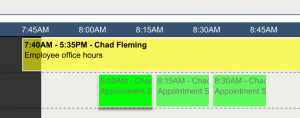 Let’s face it. We optometrists who have been practicing for a while like our comfort zones and tend to resist something new. However, electronic health records and the Affordable Care Act are changing how we do business, and we would be wise to pay attention to the ramifications.
Let’s face it. We optometrists who have been practicing for a while like our comfort zones and tend to resist something new. However, electronic health records and the Affordable Care Act are changing how we do business, and we would be wise to pay attention to the ramifications.
In the past, optometrists depended upon the comprehensive eye exam to be the main source of revenue generation. Appointment schedule templates reflected this by allowing for a good number of these every day. Appointments for other care, like a red eye evaluation or a contact lens evaluation–while extremely important to patient care–have been minimally profitable from the eyes of the practice’s CEO. Consequently, these visits were limited in number, or scheduled around the more lucrative comprehensive exams.
Moving from this traditional refractive-based mindset to the new medical model mindset will require changes in the fundamentals of your business right down to your schedule template. Here are three reasons why you should no longer designate a specific type of appointment for a specific time:
- Online patient scheduling – Many of you have not planned for online scheduling, but as more professionals offer patients the convenience of booking their own appointments online, optometry will be expected to follow suit. If the online appointment slots allow for any type of patient encounter the process is simplified for the patients. When patients are successfully scheduling their own appointments your staff is free to focus on other jobs in the office.
- Supply/Demand – If your schedule has two comprehensive exams per hour plus a check time for contact lenses or acute care, then a bunch of patients needing comprehensive exams may have to wait for a couple of days or weeks while your check times remain open. The medical model approach to patient care will actually decrease the amount of time required for a comprehensive exam. Having three or four “any type” appointments in an hour allows a doctor to treat the needs of the patients as they come, without leaving unfilled slots in a schedule due to a limited appointment template.
- Decreasing reimbursements – Most are quite aware of the reimbursement
 chopping the 92000 ophthalmological coding tree has taken. Practices continuing to focus on the traditional comprehensive mindset will see the greatest hits to their profit margin. As reimbursements continue to decline, practices that are problem-focused will be better able to manage their patients. With the new mindset, revenue per patient could continue to remain steady or potentially increase based on the new approach to the appointment template.
chopping the 92000 ophthalmological coding tree has taken. Practices continuing to focus on the traditional comprehensive mindset will see the greatest hits to their profit margin. As reimbursements continue to decline, practices that are problem-focused will be better able to manage their patients. With the new mindset, revenue per patient could continue to remain steady or potentially increase based on the new approach to the appointment template.
Vision is the ability to see those things ahead of you that will require you to make an adjustment to your predetermined path. Having vision for the future of your practice requires you to assess the way you do things now and ask yourself if the current systems will continue to serve you well in the future.





